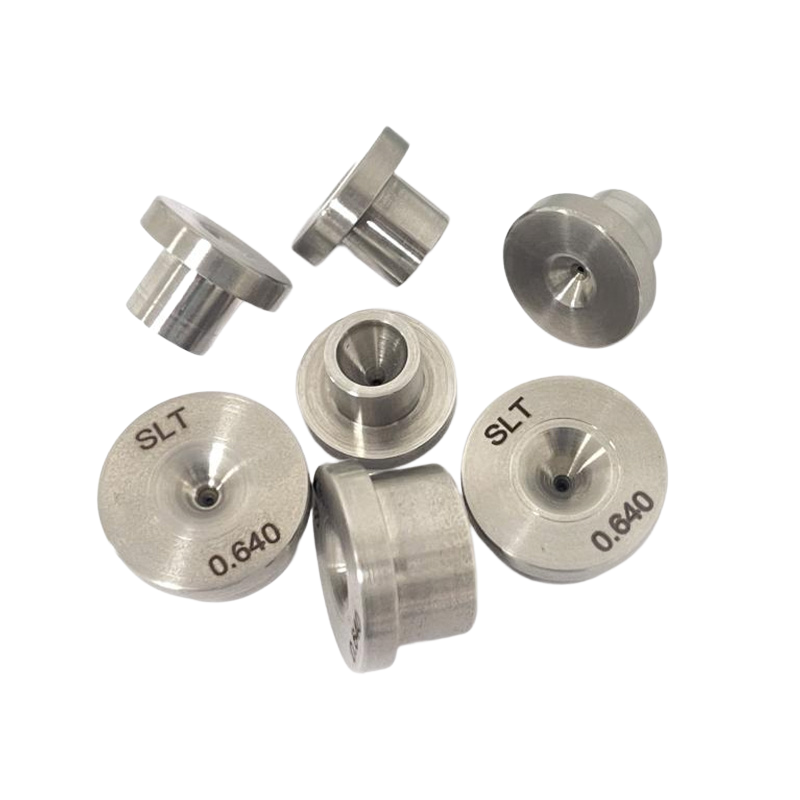Solid Die VS TC Die
Solid Die
TC Die
In modern manufacturing, die technology is the key to producing high-quality products. Especially in the metal processing and cable manufacturing industries, understanding and using appropriate dies is crucial to production efficiency and product quality. This article will explore two important dies: solid die and TC die, and their applications in production, especially TC wire drawing dies.
What is a Solid Die?
A solid die is a die made of a whole piece of material, commonly used in metal forming and processing. This die has no internal gaps or dividing lines, ensuring precision and consistency during processing. The main materials of solid dies include high-strength steel and cemented carbide, which can withstand high pressure and temperature, and have high durability and wear resistance.

Solid dies are widely used in industrial production, especially in situations where high precision and high durability are required. For example, in wire and cable manufacturing, solid stranding dies are used to accurately strand multiple wires together to form a stable cable core. This high-precision stranding process ensures that the cable has excellent electrical conductivity and mechanical strength.
What is a TC Die?
TC die, or Tungsten Carbide die, is a die made of tungsten carbide material. Tungsten carbide is known for its extremely high hardness and wear resistance and is an ideal die material. TC dies are particularly suitable for processing processes that require high strength and high wear resistance, and are widely used in wire drawing, metal forming and other fields.
Tungsten carbide wire drawing dies play an important role in metal wire manufacturing. The wire drawing process is the process of drawing metal bars through the die aperture into fine wires, which requires the die to have extremely high wear resistance and precision. Due to its superior hardness and wear resistance, TC dies can maintain a stable aperture size during high-intensity drawing processes, ensuring the production of high-quality metal wires.
Application comparison of solid dies and tungsten carbide dies
Although both solid dies and tungsten carbide dies are widely used in industrial production, they have certain differences in application. Solid dies are usually used in processing processes that require high precision and high durability, such as cable stranding. Carbide dies are more often used in high-strength, high-wear processing situations, such as the drawing of metal wires.
In the manufacture of wires and cables, solid dies and carbide wire drawing dies are often used in combination. Solid dies ensure the precise arrangement and twisting of wires, while carbide wire drawing dies are responsible for drawing thick wires into thin wires of the required diameter. This combination can maximize production efficiency and product quality, and meet the needs of modern industry for high-performance wires and cables.
Technological innovation and future development
With the continuous advancement of science and technology, the manufacturing technology of solid dies and carbide dies is also developing. The application of advanced CNC machining technology and new materials has continuously improved the precision and durability of dies. At the same time, the introduction of intelligent manufacturing technology has also made the design and production of dies more flexible and efficient.
Looking to the future, the application of solid dies and carbide dies in industrial production will be more extensive and in-depth. With the continuous innovation of manufacturing processes, these two dies will play an important role in more fields and provide strong support for the efficiency and quality improvement of industrial production.
In short, solid molds and carbide molds are indispensable tools in modern industrial production. By understanding and applying these mold technologies, manufacturing companies can significantly improve production efficiency and product quality and meet the market demand for high-performance and high-reliability products. In the future, with the continuous advancement of technology, these molds will continue to play a key role in various industrial fields and promote the sustainable development of the manufacturing industry.
 English
English Español
Español Português
Português русский
русский français
français 日本語
日本語 Deutsch
Deutsch Tiếng Việt
Tiếng Việt Nederlands
Nederlands ไทย
ไทย Polski
Polski 한국어
한국어 Svenska
Svenska magyar
magyar Malay
Malay বাংলা
বাংলা Dansk
Dansk Suomi
Suomi हिन्दी
हिन्दी Pilipino
Pilipino Türk
Türk Gaeilge
Gaeilge عربى
عربى Indonesia
Indonesia norsk
norsk čeština
čeština Ελληνικά
Ελληνικά Українська
Українська नेपाली
नेपाली Burmese
Burmese български
български ລາວ
ລາວ Latine
Latine slovenský
slovenský Lietuvos
Lietuvos

Changzhou Shen Litong Mould invites you to visit the exhibition
From August 27th to 29th, 2025, at SHANGHAI NEW INTERNATIONAL EXPO CENTRE,the 12th China International Wire&Cable Industry Exhibition (Hall E1, G21), Shen Litong Dies sincerely invites you to visit, exchange and offer guidance, and jointly explore new developments in the industry.
Read MoreOptimizing Your Wire Drawing Process: Selecting the Ideal Die Configuration for Material & Application
The wire drawing process is a critical metal forming operation that reduces the cross-section of wire by pulling it through a series of progressively smaller dies.
Read MoreCommon Wire Surface Defects: Causes and Die-Related Solutions
Abrasions or Built-up Edges (BUE): Accumulation of wire material (e.g., copper, aluminum) on the die surface, which then scratches subsequent wire.
Read More